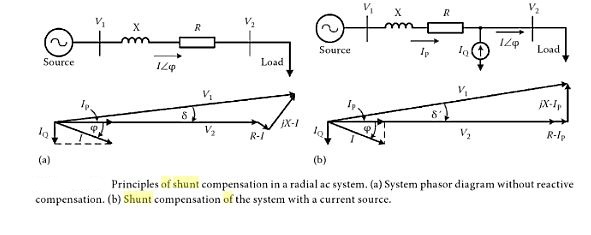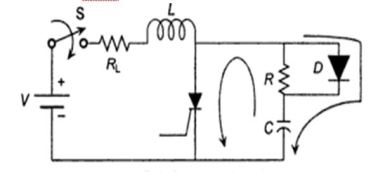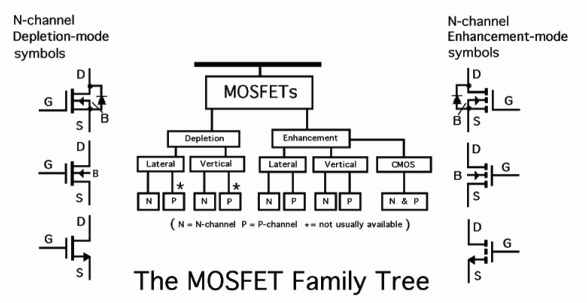ARIO WICAKSONO DAMANIK
115090052
1. What are the parameters for controlling power is a transmission line?
115090052
1. What are the parameters for controlling power is a transmission line?
Jawab:
Line impedance, magnitude and phase angle of bus voltage
2. What is the basic principle of shunt compensator?
Jawab:
Figure shows the principle and theoretical effects of shunt reactive power compensation in a basic ac system, which comprises a source V1, a transmission line and typical inductive load. Figure (a) shows the system without compensation, and its associated phasor diagram. In the phasor diagram the phase angel of the current has been related to the load side, which means that active current Ip is in phase with the load voltage V2. Since the load is assumed inductive, it requires reactive power for proper operation, which must be supplied by the source, increasing the current flow from the generator and through the lines. If reactive Is supplied near the load, the line current is minimized, reducing power losses and improving voltage regulation at the load terminals. This can be done with a capacitor, with a voltage source, or with a current source. In figure (b), a current-source device is being used to compensate the reactive component of the load current (IQ). As a result, the system voltage regulation is improved and the reactive current component from the source is almost eliminated.
A current source or a voltage source can be used for reactive shunt compensation. The main advantages of using voltage or current source VAR generator (instead of inductor or capacitor) are that the reactive power generated is independent of the voltage at the point of connection and can be adjusted in a wide range.
3. What is the TCR?
Jawab:
Thyristor-Controlled Reactor adalah jenis dari compensator yand dibuat dari sebuah supplai induktansi melalui ac -ac converter menggunakan dua buah thyristor anti paralel.
4. What is the TSC
Jawab:
Thyristor switched capacitor) adalah rangkaian yang digunakan untuk mengkompensasi daya reaktif pada sistem elektronika daya. TSC terdiri atas kapasitor daya yang disambung seri dengan bidirectional thyristor, dan biasa digunakan membatasi induktor (reaktor). TSC merupakan komponen yang penting bagi Static VAR Compensator (SVC).
5. What is the SVC
Jawab:
SVC adalah mengatur besarnya VAR dan tegangan dengan mengatur besar daya reaktif intduktif dari reaktor serta menyediakan daya reaktif dengan reaksi yang cepat
6. What is the statcom
Jawab:
Static Synchronous Compensator, injeksi arus melalui tranformator yang berfungsi sebagai penyedia Volt Ampere Reactive (VAR) untuk menjaga kestabilan voltase pada jaringan transimi yang panjang dan berbeban tinggi
7. What is the basic principle of series compensation
Jawab:
Pada series compensation, the FACTS (Flexible AC transmission system) dihubungkan seri dengan sistem daya. Hal ini bekerja sebagai pengontrol tegangan sumber. Induktansi seri selalu digunakan pada semua jalur transmisi AC. Pada jalur yang panjang, ketika arus besar mengalir, hal ini menyebabkan drop tegangan yang besar. Untuk mengkompensasi tegangan drop ini, kapasitor seri dihubungkan untuk mengurangi efek dari induktansi.
8. What is the TSSC
Jawab:
Thyristor Switched Series Capacitor merupakan rangkaian seri kapasitor yang dihubung singkat oleh sebuah reaktor thyristor-switched.
9. What is the TCSC
Jawab:
Thyristor Controlled Series Capasitor yang berfungsi sebagai pengendali impedansi dari jaringan transimis
10. What is the FCSC
Jawab:
Forced Commutation Controlled Series Capacitor merupakan rangkaian yang dibentuk oleh kapasitor seri dengan kontroler. Cara kerja FCSC sama dengan TSC, kecuali pada switch diganti dengan alat pendorong secara komutatif.
11. What is a series stacom
Jawab:
SSSC (static Synchronous series compensator) yang berarti rangkaian seri alat Flexible AC transmission system /FACTS menggunakan elektronika daya untuk mengontrol aliran daya dan meningkatkan osilasi daya menguasai jalur daya. The SSSC menginfus sebuah tegangan Vs dihubung seri dengan jalur transmisi yang tekoneksi.
12. What is the basic principle of phase angle compensation
Jawab:
Prinsip dasar kompensasi sudut phasa adalah untuk meningkatkan strategi LVRT (Low voltage ride through) yang ada.
13. What is the phase shifter
Jawab:
Penghubung dua sistem dengan phasa yang berlebihan atau perbedaan phasa yang tidak terkontrol. namun hal ini megizinkan pengaturan besar beda phasa.
14. What is quadrature booster (QB)
Jawab:
Quadrature booster dapat menyediakan tegangan dengan instalasi yang sesuai dengan koneksi pada trafo. Trafo menyediakan pergeseran phasa yang penting atau tegangan quadrature sekitar sistem untuk mengendalikan arus yang sesuai.
15. What is the UPFC
Jawab:
Unified Power Flow Controller, dapat mengendalikan impedansi transimis, tegangan dan sudut fasa. UPFC merupakan kombinasi statcom dan SSSC.
16. What are the rule for transient free switching of thyristor
jawab:
- To turn a thyristor (or triac) ON, a gate current ≥ IGT must be applied until the load current is ≥ IL. This condition must be met at the lowest expected operating temperature.
- To turn off (commutate) a thyristor (or triac), the load current must be < IH for sufficient time to allow a return to the blocking state. This condition must be met at the highest expected operating temperature.
- When designing a triac triggering circuit, avoid triggering in the 3+ quadrant (MT2-, G+) where possible.
- To minimise noise pickup, keep gate connection length to a minimum. Take the return directly to MT1 (or cathode). If hard wired, use twisted pair or shielded cable. Fit a resistor of 1kΩ or less between gate and MT1. Fit a bypass capacitor in conjunction with a series resistor to the gate. Alternatively, use an insensitive series H triac.
17. What are switch capasitor
jawab:
is an electronic circuit element used for discrete time signal processing
18. What is the SSVC
Jawab:
Solid State Var Compensator bekerja pada tegangan inverter PWM. Inverter dihubungkan oleh tegangan AC melalui reaktor. Sebuah kapasitor DC terhubung ke sisi DC dari VAR compensator. Kapasitor berfungsi mempertahankan rippe tegangan DC pada input serta menyimpan daya reaktif, lalu SSVC terhubung ke beban melalui LPF orde dua yang mengurangi arus harmonik komponen sebagai jaringan utilities.




